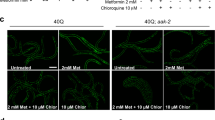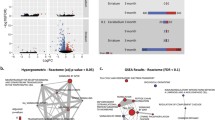Abstract
The R6/2 transgenic mouse model of Huntington’s disease (HD) develops a progressive neurological phenotype that involves severe motor and cognitive dysfunctions. Although not a cardinal sign, diabetes has been described in R6/2 mice. It is not clear, however, whether the diabetes contributes to the HD-like phenotype of R6/2 mice. In our study we found that the severity of diabetes in R6/2 mice was associated with the progressive formation of ubiquinated inclusions in pancreatic beta cells. Diabetes is dissociated from early motor and cognitive dysfunctions and did not correlate with motor impairment and survival of R6/2 mice. However, chronic behavioural testing (at a level higher than that which is reported to improve several aspects of the R6/2 phenotype) exacerbated the onset of diabetes. Pharmacological treatment of the diabetes was attempted using two oral hypoglycaemic agents commonly used by diabetics. The mice responded acutely to glibenclamide (which induces exocytosis of insulin) but not to rosiglitazone (which induces sensitization to insulin). This supports the suggestion that the diabetes in R6/2 mice is caused by an impairment in insulin release rather than insulin insensitivity. However, chronic treatment with these hypoglycaemic agents had no effect on either the course of the diabetes or the disease in R6/2 mice.





Similar content being viewed by others
References
Abderrahmani A, Niederhauser G, Plaisance V, Roehrich ME, Lenain V, Coppola T, Regazzi R, Waeber G (2004) Complexin I regulates glucose-induced secretion in pancreatic beta-cells. J Cell Sci 117:2239–2247
Andreassen OA, Dedeoglu A, Stanojevic V, Hughes DB, Browne SE, Leech CA, Ferrante RJ, Habener JF, Beal MF, Thomas MK (2002) Huntington’s disease of the endocrine pancreas: insulin deficiency and diabetes mellitus due to impaired insulin gene expression. Neurobiol Dis 11:410–424
Armario A, Martí J, Gil M (1990) The serum glucose response to acute stress is sensitive to the intensity of the stressor and to habituation. Psychoneuroendocrinology 15:341–347
Ashcroft SJ, Ashcroft FM (1992) The sulfonylurea receptor. Biochim Biophys Acta 1175:45–59
Bjorkqvist M, Fex M, Renstrom E, Wierup N, Petersen A, Gil J, Bacos K, Popovic N, Li JY, Sundler F, Brundin P, Mulder H (2005) The R6/2 transgenic mouse model of Huntington’s disease develops diabetes due to deficient beta-cell mass and exocytosis. Hum Mol Genet 14:565–574
Brackenridge CJ (1979) Relation of occupational stress to the age at onset of Huntington’s disease. Acta Neurol Scand 60:272–276
Carter RJ, Lione LA, Humby T, Mangiarini L, Mahal A, Bates GP, Dunnett SB, Morton AJ (1999) Characterization of progressive motor deficits in mice transgenic for the human Huntington’s disease mutation. J Neurosci 19:3248–3257
Carter RJ, Hunt MJ, Morton AJ (2000) Environmental stimulation increases survival in mice transgenic for exon 1 of the Huntington’s disease gene. Mov Disord 15:925–937
Cha JH, Kosinski CM, Kerner JA, Alsdorf SA, Mangiarini L, Davies SW, Penney JB, Bates GP, Young AB (1998) Altered brain neurotransmitter receptors in transgenic mice expressing a portion of an abnormal human Huntington disease gene. Proc Natl Acad Sci USA 95:6480–6485
Connor SC, Hughes MG, Moore G, Lister CA, Smith SA (1997) Antidiabetic efficacy of BRL 49653, a potent orally active insulin sensitizing agent, assessed in the C57BL/KsJ db/db diabetic mouse by non-invasive 1H NMR studies of urine. J Pharm Pharmacol 49:336–344
Craft S, Watson GS (2004) Insulin and neurodegenerative disease: shared and specific mechanisms. Lancet Neurol 3(3):169–178
De Boer SF, Koopmans SJ, Slangen JL, Van der Gugten J (1990) Plasma catecholamine, corticosterone and glucose responses to repeated stress in rats: effect of interstressor interval length. Physiol Behav 4:1117–1124
Durant S, Christeff N, Coulaud J, Nunez EA, Dardenne M, Homo-Delarche F (1998) Basal concentrations of various steroids in the nonobese diabetic (NOD) mouse and effect of immobilization stress. Autoimmunity 28:249–258
Evans JL, Goldfine ID, Maddux BA, Grodsky GM (2002) Oxidative stress and stress-activated signaling pathways: a unifying hypothesis of type 2 diabetes. Endocr Rev 23:599–622
Fain JN, Del Mar NA, Meade CA, Reiner A, Goldowitz D (2001) Abnormalities in the functioning of adipocytes from R6/2 mice that are transgenic for the Huntington’s disease mutation. Hum Mol Genet 10:145–152
Farrer LA (1985) Diabetes mellitus in Huntington disease. Clin Genet 27:62–67
Ferrante RJ, Andreassen OA, Jenkins BG, Dedeoglu A, Kuemmerle S, Kubilus JK, Kaddurah-Daouk R, Hersch SM, Beal MF (2000) Neuroprotective effects of creatine in a transgenic mouse model of Huntington’s disease. J Neurosci 20:4389–4397
Fuhlendorff J, Rorsman P, Kofod H, Brand CL, Rolin B, MacKay P, Shymko R, Carr RD (1998) Stimulation of insulin release by repaglinide and glibenclamide involves both common and distinct processes. Diabetes 47(3):345–351
Glass M, van Dellen A, Blakemore C, Hannan AJ, Faull RL (2004). Delayed onset of Huntington’s disease in mice in an enriched environment correlates with delayed loss of cannabinoid CB1 receptors. Neuroscience 123(1):207–212
Goodyear LJ, Kahn BB (1998) Exercise, glucose transport, and insulin sensitivity. Annu Rev Med 49:235–261
Henriksen EJ (2002) Invited review: effects of acute exercise and exercise training on insulin resistance. J Appl Physiol 93:788–796
Ho FM, Liu SH, Liau CS, Huang PJ, Lin-Shiau SY (2000) High glucose-induced apoptosis in human endothelial cells is mediated by sequential activations of c-Jun NH(2)-terminal kinase and caspase-3. Circulation 101:2618–2624
Hockly E, Cordery PM, Woodman B, Mahal A, van Dellen A, Blakemore C, Lewis CM, Hannan AJ, Bates GP (2002) Environmental enrichment slows disease progression in R6/2 Huntington’s disease mice. Ann Neurol 51(2):235–242
Huntington’s Disease Collaborative Research Group (1993) A novel gene containing a trinucleotide repeat that is expanded and unstable on Huntington’s disease chromosomes. Cell 72:971–983
Hurlbert MS, Zhou W, Wasmeier C, Kaddis FG, Hutton JC, Freed CR (1999) Mice transgenic for an expanded CAG repeat in the Huntington’s disease gene develop diabetes. Diabetes 48:649–651
Jenkins BG, Klivenyi P, Kustermann E, Andreassen OA, Ferrante RJ, Rosen BR, Beal MF (2000) Nonlinear decrease over time in N-acetyl aspartate levels in the absence of neuronal loss and increases in glutamine and glucose in transgenic Huntington’s disease mice. J Neurochem 74(5):2108–2119
Jucker BM, Schaeffer TR, Haimbach RE, McIntosh TS, Chun D, Mayer M, Ohlstein DH, Davis HM, Smith SA, Cobitz AR, Sarkar SK (2002) Normalization of skeletal muscle glycogen synthesis and glycolysis in rosiglitazone-treated Zucker fatty rats: an in vivo nuclear magnetic resonance study. Diabetes 51(7):2066–2073
Lione LA, Carter RJ, Hunt MJ, Bates GP, Morton AJ, Dunnett SB (1999) Selective discrimination learning impairments in mice expressing the human Huntington’s disease mutation. J Neurosci 19:10428–10437
Liu YF (1998) Expression of polyglutamine-expanded Huntingtin activates the SEK1-JNK pathway and induces apoptosis in a hippocampal neuronal cell line. J Biol Chem 273:28873–28877
Luesse HG, Schiefer J, Spruenken A, Puls C, Block F, Kosinski CM (2001) Evaluation of R6/2 HD transgenic mice for therapeutic studies in Huntington’s disease: behavioral testing and impact of diabetes mellitus. Behav Brain Res 126:185–195
Mangiarini L, Sathasivam K, Seller M, Cozens B, Harper A, Hetherington C, Lawton M, Trottier Y, Lehrach H, Davies SW, Bates GP (1996) Exon 1 of the HD gene with an expanded CAG repeat is sufficient to cause a progressive neurological phenotype in transgenic mice. Cell 87:493–506
Miller TW, Shirley TL, Wolfgang WJ, Kang X, Messer A (2003) DNA vaccination against mutant huntingtin ameliorates the HDR6/2 diabetic phenotype. Mol Ther 7(5 Pt 1):572–579
Morton AJ, Edwardson JM (2001) Progressive depletion of complexin II in a transgenic mouse model of Huntington’s disease. J Neurochem 76:166–172
Morton AJ, Lagan MA, Skepper JN, Dunnett SB (2000) Progressive formation of inclusions in the striatum and hippocampus of mice transgenic for the human Huntington’s disease mutation. J Neurocytol 29:679–702
Nakai N, Miyazaki Y, Sato Y, Oshida Y, Nagasaki M, Tanaka M, Nakashima K, Shimomura Y (2002) Exercise training increases the activity of pyruvate dehydrogenase complex in skeletal muscle of diabetic rats. Endocr J 49:547–554
Podolsky S, Leopold NA (1977) Abnormal glucose tolerance and arginine tolerance tests in Huntington’s disease. Gerontology 23:55–63
Podolsky S, Leopold NA, Sax DS (1972) Increased frequency of diabetes mellitus in patients with Huntington’s chorea. Lancet 1:1356–1358
Ribchester RR, Thomson D, Wood NI, Hinks T, Gillingwater TH, Wishart TM, Court FA, Morton AJ (2004) Progressive abnormalities in skeletal muscle and neuromuscular junctions of transgenic mice expressing the Huntington’s disease mutation. Eur J Neurosci 20:3092–3114
Sathasivam K, Hobbs C, Turmaine M, Mangiarini L, Mahal A, Bertaux F, Wanker EE, Doherty P, Davies SW, Bates GP (1999) Formation of polyglutamine inclusions in non-CNS tissue. Hum Mol Genet 8:813–822
Schubotz R, Hausmann L, Kaffarnik H, Zehner J, Oepen H (1976) Fatty acid patterns and glucose tolerance in Huntington’s chorea (author’s transl). Res Exp Med (Berl) 167:203–215
Squitieri F, Cannella M, Simonelli M (2002) CAG mutation effect on rate of progression in Huntington’s disease. Neurol Sci 23(Suppl 2):S107–108
Surwit RS, McCubbin JA, Livingston EG, Feinglos MN (1985) Classically conditioned hyperglycemia in the obese mouse. Psychosom Med 47:565–568
Surwit RS, McCubbin JA, Kuhn CM, McGee D, Gerstenfeld D, Feinglos MN (1986) Alprazolam reduces stress hyperglycemia in ob/ob mice. Psychosom Med 48:278–282
Surwit RS, Schneider MS, Feinglos MN (1992) Stress and diabetes mellitus. Diabetes Care 15:1413–1422
Trube G, Rorsman P, Ohno-Shosaku T (1986) Opposite effects of tolbutamide and diazoxide on the ATP-dependent K+ channel in mouse pancreatic beta-cells. Pflugers Arch 407:493–499
Wolffenbuttel BH, Gomis R, Squatrito S, Jones NP, Patwardhan RN (2000) Addition of low-dose rosiglitazone to sulphonylurea therapy improves glycaemic control in Type 2 diabetic patients. Diabet Med17(1):40–47
Yasuda S, Inoue K, Hirabayashi M, Higashiyama H, Yamamoto Y, Fuyuhiro H, Komure O, Tanaka F, Sobue G, Tsuchiya K, Hamada K, Sasaki H, Takeda K, Ichijo H, Kakizuka A (1999) Triggering of neuronal cell death by accumulation of activated SEK1 on nuclear polyglutamine aggregations in PML bodies. Genes Cells 4:743–756
Young PW, Cawthorne MA, Coyle PJ, Holder JC, Holman GD, Kozka IJ, Kirkham DM, Lister CA, Smith SA (1995) Repeat treatment of obese mice with BRL 49653, a new potent insulin sensitizer, enhances insulin action in white adipocytes. Association with increased insulin binding and cell-surface GLUT4 as measured by photoaffinity labeling. Diabetes 44:1087–1092
Acknowledgements
This work was funded by the CURE HD initiative of the Hereditary Disease Foundation. We would like to thank Wendy Leavens for technical assistance.
Author information
Authors and Affiliations
Corresponding author
Rights and permissions
About this article
Cite this article
Hunt, M.J., Morton, A.J. Atypical diabetes associated with inclusion formation in the R6/2 mouse model of Huntington’s disease is not improved by treatment with hypoglycaemic agents. Exp Brain Res 166, 220–229 (2005). https://doi.org/10.1007/s00221-005-2357-z
Received:
Accepted:
Published:
Issue Date:
DOI: https://doi.org/10.1007/s00221-005-2357-z




